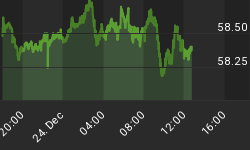The interesting and generally questionable conclusions in the April consumer price report provided a false sense of comfort in global financial markets that we believe will be temporary. The finding that the cost of domestic gasoline fell -2.0% month over month during a time when prices at the pump soared well above $4.0 per gallon in many areas was behind the modest official increase in the cost of living for the month. However, savvy market participants that follow the inflation data closely understand that the seasonal adjustments often tend to overshoot the true nature of the data and are prone to monthly revisions. We expect that the data in the coming months will be revised to reflect the reality of what is occurring in the price environment.
Perhaps more interesting and completely overlooked in the CPI data was the steady increase in the cost of food. In April the cost of food advanced 0.9% month over month and 5.1% year over year. This represented an eighteen-year high on both accounts and does put a very serious dent in the foundation of Fed assumptions regarding the evolution of inflation. For the past year the Fed has continuously made the case that since the government begin tracking food inflation that the cost of food has not increased in two consecutive years since the Great Depression. Thus, the central bank has been implying for several months that one of the two major drivers of headline inflation (the other being the cost of imported oil) will see declines during 2008.
Forgive us if we strenuously disagree. In our analysis the change in the pricing environment for commodities is the result of a significant and long lasting change in the composition of demand on a global basis for commodities and energy. As such, the relative change in pricing for energy and commodities will not be transitory and prove quite durable.
To put things in perspective, the wealth now being built in China, India and in many emerging markets has permanently altered the supply and demand equation. For the first time many individuals are wealthy enough to purchase protein and are now substituting the consumption of lower cost poultry for much more expensive beef. Why does this matter? According to the US Department of Agriculture it requires 700 calories worth of feed to produce 100 calories worth of beef. Thus, the change in dietary habits in the emerging world has stimulated a far-reaching increase in demand for grains. When one accounts for the policy changes (erroneous in our view) resulting in the move towards ethanol based gasoline and the development of $125 per barrel of oil this has produced a what looks to be a permanent change in the cost of living that will bleed through to the Fed's cherished core rate of inflation.
The result is that recent readings in inflation will prove transitory. Both headline and core rates of pricing will see moves well above what both the Fed, the market and the public will find tolerable. Given the unorthodox approach to dealing with the evolving credit crisis, even with a Fed on pause until after the election, the global system will continue to be flush with liquidity which will drive the dollar lower, the cost of energy and commodities towards the heavens and inflation much higher.
| Date | Data | Consensus | Merk | Actual | Previous |
| 5/19/08 | Leading Indicators | -0.1 | -0.1 | 0.1 | |
| 5/20/08 | PPI | 0.4 | 0.5 | 1.1 | |
| 5/20/08 | PPI Ex F&E | 0.2 | 0.2 | 0.2 | |
| 5/21/08 | FOMC Minutes | n/a | n/a | n/a | |
| 5/22/08 | Initial Claims | n/a | 370 | 371 | |
| 5/23/08 | Existing Home Sales | 4.85 | 4.82 | 4.93min |
















